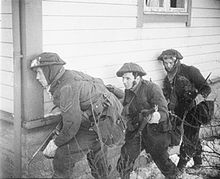Derek Mills-Roberts
Derek Mills-Roberts | |
|---|---|
 Derek Mills – Roberts (foreground, standing) at the glider landing grounds near Ranville, 7 June 1944. | |
| Born | 23 November 1908 |
| Died | 1 October 1980 (aged 71) |
| Allegiance | |
| Service | 1st Special Service Brigade |
| Rank | Brigadier |
| Awards | Commander of the Order of the British Empire, Distinguished Service Order and Bar, Military Cross, Legion D'Honneur, Croix de Guerre. |

Brigadier Derek Mills-Roberts, CBE, DSO and bar, MC (23 November 1908 – 1 October 1980) was a British commando who fought with the 1st Special Service Brigade during World War II. In a quirk of military history, he became the only Allied soldier to strike an enemy flag officer with the latter's own staff-of-office – when Mills-Roberts bashed Erhard Milch over the head with the just-surrendered marshal's baton.
Early life
Derek Mills-Roberts was born on 23 November 1908 in England. During the 1930s, he trained to become a lawyer at Liverpool College and the University of Oxford. On 3 October 1936, he was commissioned into the Irish Guards Supplementary Reserve of Officers as a second lieutenant, having been an officer cadet of the University of Oxford contingent of the Officer Training Corps.[1] It was at Oxford that Derek met his good friend Lord Lovat. Derek and Lord Lovat had actually got off on a bad start. They had a rivalry which involved a heated argument and an exchange of blows. From that time on however, they became close friends. After graduation from Oxford, Derek worked for his father's law firm.
World War II
Mills-Roberts began his military service in the No.4 Commando Unit. His good friend, Lord Lovat was given command of the unit, while Derek served as Second in Command. On 3 March 1941, Mills-Roberts, in the No. 4 Commando Unit, launched a raid on the German-occupied Lofoten Islands. In the successful raid, the commandos destroyed a significant number of fish-oil factories, petrol dumps and 11 ships. They also seized encryption equipment and codebooks. In addition to the destruction of materials, the commandos captured 216 German troops, and 315 Norwegians chose to accompany the commandos back to Britain. In August 1942, Derek was involved in the disastrous Dieppe Raid.[2] The raid, a small scale invasion mounted by Canadian infantry and British commandos against Adolf Hitler's Atlantic Wall, was a complete failure and the units involved suffered very heavily. Lovat and Mills-Roberts's involvement in the raid was to secure the opposing flanks of the landing area and to destroy coastal batteries. By October 1942, he was a lieutenant (temporary captain) (acting major).[2]
In late 1942, Mills-Roberts was promoted to Lieutenant-Colonel and given command of No.6 Commando Unit; he was then stationed in North Africa.
Later in the war, among other actions, he took part in the Bergen-Belsen concentration camp's liberation. When Luftwaffe Field Marshal Erhard Milch was captured and surrendered his command baton to Mills-Roberts, the latter vented his anger about the atrocities he had seen at Bergen-Belsen by savagely beating Milch with a champagne bottle, after breaking the baton over Milch's head with numerous blows. Milch sustained a fractured skull and a number of contusions from this assault. This incident was filmed by a British soldier.[3][unreliable source?] By June 1945, he was a brigadier (temporary).[4]
Honours and decorations
Mills-Roberts was awarded the Military Cross on 2 October 1942 "in recognition of gallant and distinguished services in the combined attack on Dieppe".[2] He was awarded the Distinguished Service Order (DSO) on 22 April 1943 "in recognition of gallant and distinguished services in North Africa".[5] He was awarded a medal bar to his Distinguished Service Order (DSO and bar) on 21 June 1945 "in recognition of gallant and distinguished services in North-West Europe".[4] In the 1950 New Year Honours, he was appointed Commander of the Order of the British Empire (CBE).[6]
- Commander of the Order of the British Empire
- Distinguished Service Order and Bar
- Military Cross
- Légion d'honneur
- Croix de Guerre
References
- ^ "No. 34328". The London Gazette. 2 October 1936. p. 6277.
- ^ a b c "No. 35729". The London Gazette (Supplement). 2 October 1942. p. 4328.
- ^ http://www.fpp.co.uk/docs/ReadersLetters/EvStd200886.html
- ^ a b "No. 37138". The London Gazette (Supplement). 19 June 1945. p. 3231.
- ^ "No. 35987". The London Gazette (Supplement). 20 April 1943. p. 1846.
- ^ "No. 39104". The London Gazette (Supplement). 29 December 1950. p. 6.
- 1908 births
- 1980 deaths
- English soldiers
- British Army personnel of World War II
- British Army Commandos officers
- Recipients of the Military Cross
- Companions of the Distinguished Service Order
- Commanders of the Order of the British Empire
- Recipients of the Croix de Guerre 1939–1945 (France)
- Légion d'honneur recipients
- Operation Overlord people
